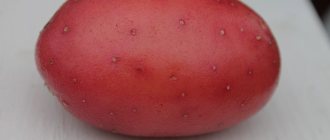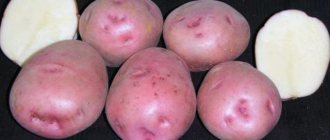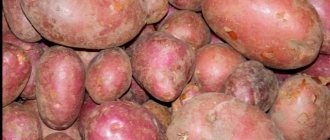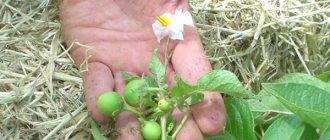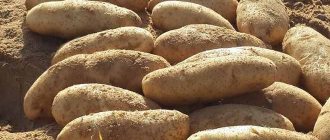Zorachka potatoes were obtained in Belarus. It was entered into the State Register of Russia in 2013 based on the results of tests that confirmed its characteristics. This species is recommended for cultivation in the Central and Northwestern regions. The variety is popular among gardeners due to its short growing season. Therefore, it is often grown to produce young potatoes with excellent taste.
Darkening of the pulp of the Zorachka variety does not occur upon contact with air
Description of the potato variety Zorachka
This species forms low or medium bushes with a maximum height of no more than 60 cm. The shoots are semi-erect, 0.7-1.0 cm thick. As they grow, the central stems gradually bend to the sides.
Zorachka's leaves can be medium or large, 10-12 cm long. The color of the plates is dark green. There is wavyness along the edge. Each potato bush has 4-5 shoots. The leaves on them are located mostly on top, and below they are bare.
Zorachka's inflorescences are red-violet. They consist of 4-5 buds of medium diameter. Petals fused at the base. When planting potatoes early, flowering occurs in mid-June.
Under each bush of the Zorachka variety, 9-10 medium tubers are formed. Large and small specimens are practically never found. The average fruit weight is 90-120 g. The potatoes are oval, slightly elongated. The surface is smooth, the peel has a yellow tint. The flesh is the same color, only a few shades lighter. It has a dense consistency. The eyes are small, sparse, and shallowly located. Starch content is within 12-14%. The variety's discoloration is minimal.
Important! Zorachka is recommended to be grown in a temperate climate, as the variety does not respond well to heat and lack of moisture.
This potato is not susceptible to temperature changes. It can be grown on any soil with a neutral acidity level.
The yield of marketable potatoes for the Zorachka variety is 88-96%
Taste qualities of Zorachka potatoes
Fruits without wateriness. The taste of Zorachka potatoes is assessed as good. During heat treatment, the structure and shade of the pulp does not change.
Harvesting and storage
The Zorachka harvest occurs early. The first excavations are made approximately 45-50 days after emergence. They check the varietal conformity of the tubers and their taste.
The final harvest is after 70-80 days, when the tubers reach biological maturity. Before digging, cut off the yellowed tops about 10-12 days. For harvesting, choose a dry day so that the potatoes dry slightly before storing. It is recommended to dig up early varieties with a pitchfork, carefully prying up the nests in the soil.
These early potatoes are intended for use in the summer: for food, for sale. Seed material is usually planned for planting in cellars and basements, as well as small batches for consumption in the fall.
In summer cottages, Zorachka is grown in small quantities, especially for digging up for food. Farmers choose the variety for its early ripening and the possibility of summer sales. When storing, the premises (cellars, basements, storage facilities) are first disinfected, ventilation, temperature conditions (+2ºC…+3ºC), and humidity not more than 85% are provided. Potatoes are regularly inspected, removing damaged and spoiled tubers.
On a note! Seed and food potatoes are stored separately. It is also recommended to scatter potatoes of different varieties and different ripening periods into different aisles, chests or boxes.
Characteristics of the potato variety Zorachka
Young shoots of this variety do not tolerate spring frosts well. Therefore, Zorachka should be planted in early May, when the soil temperature at a depth of 10 cm is at least + 8 °C. Potatoes have low drought tolerance. In the absence of regular watering, the size of the tubers decreases.
The species is resistant to cracking and mechanical damage. Zorachka tolerates transportation well, maintaining its presentation. Potatoes are suitable for long-term storage. Its shelf life is 96%.
The variety, due to its low level of digestibility, is ideal for preparing first courses and frying. It is not recommended to use it for purees, as grains are formed.
Zorachka potato yield
The species belongs to the mid-early category. Potatoes ripen in 70-75 days from the moment sprouts appear. Harvesting Zorachka can be done in mid-July. And you can dig up the bushes to get new potatoes after 1.5 months.
Productivity is average. If you follow the rules of agricultural technology, you can get 70 kg from one hundred square meters. This indicator directly depends on watering and timely application of fertilizers, and the level of soil acidity.
Advantages and disadvantages
Zorachka has a number of advantages, which sets the variety apart from others. This is confirmed by numerous positive reviews about this potato. But the variety also has certain disadvantages, so you should familiarize yourself with them in advance so that later they do not become an unpleasant surprise.
Zorachka is characterized by a large harvest
pros
- early ripeness;
- stable yield;
- friendly ripening of tubers;
- fruit uniformity;
- good taste;
- immunity to mechanical damage;
- high marketability;
- suitability for transportation and storage;
- resistance to many diseases.
Minuses
- affected by the Colorado potato beetle;
- does not tolerate drought well;
- needs regular loosening of the soil.
Important! When Zorachka is planted in heavy acidic soil, the potatoes become smaller and their taste deteriorates.
Rules for planting crops
The rules for planting Zorachka potatoes take into account crop rotation. Includes digging and fertilizing the soil, preparation, embedding tubers in the soil in compliance with the timing of agrotechnical work.
Deadlines for planting work
For planting potatoes, information about soil temperature is important. The roots of Zorachka tubers begin to germinate at +7 °C and above, so the activity is carried out at a stable average daily air temperature of at least +8 °C.
Article on the topic: Potato variety “Kemerovochanin” - description and photo
If you plant tubers in the soil ahead of time, the risk of rotting will increase.
In central Russia, the vegetable is planted in sunny, warm weather in early May. Pay attention to soil moisture. If there was heavy rain the day before, wait until the ground dries out.
Preparing the soil and site
Preparing the soil and site for spring planting begins immediately after harvesting the previous year's crop. First, the remaining tops and weeds are dried and burned. Drainage ditches are dug along the perimeter of the site. Check the acidity of the soil. If sorrel and horsetail are noticed in the beds, slaked lime, sulfur or sand are added to the soil.
The soil is dug up on the bayonet of a shovel, adding manure at the rate of 8 kg per 1 sq. m. m. In spring, the soil is loosened to a depth of 10–15 cm. Mineral fertilizers are applied per 1 hectare of land:
- 2 kg of potassium sulfate;
- 1 kg of ammonium nitrate;
- 4 kg of nitrophoska;
- 1 kg double superphosphate.
With a small planting area, manual digging of soil is more effective than mechanized digging.
Preparation of planting material
3–4 weeks before planting, seed material is removed from storage. A simple and affordable method of germination is in the light.
The technology consists of the following procedures:
- The tubers are sorted, removing diseased, rotten or deformed specimens.
- healthy potatoes are laid out on the floor or in boxes in 1–2 layers, after being sprayed with a solution of manganese (1 mg per 1 liter of water);
- for the first 10 days, planting material is kept indoors at a temperature of 18–20 °C;
- To prevent the sprouts from stretching, the potatoes are transferred to another place with a temperature of 10–13°C.
Immediately before planting, the sprouted tubers are treated with the growth stimulator Kornevin and the complex insecticidal and fungicidal preparation Prestige.
Scheme and depth of planting seedlings
Zorachka potatoes are planted in holes 8–10 cm deep, located at a distance of 40 cm from each other. Row spacing is 60 cm.
Landing rules
The Zorachka variety should be planted in early May. If there is a threat of return frosts, be sure to cover the plantings with agrofibre so that the sprouts are not damaged. Maximum productivity can be achieved by growing these potatoes on loam with good aeration.
Site preparation should begin in the fall. It involves deep plowing with the addition of manure to the soil at the rate of 200 kg per hundred square meters. In case of increased acidity of the soil, you need to add more lime or dolomite flour.
With the arrival of spring, the bed should be dug up and the surface leveled. Holes for Zorachka potatoes should be made at a distance of 30 cm, and a distance of 60 cm should be maintained between rows. This planting scheme allows for high-quality hilling of the bushes and guarantees their uniform lighting and ventilation.
Important! It is recommended to additionally add a pinch of wood ash to each hole and mix it thoroughly with the soil.
Reviews
Galina:
“Zorachka is a worthy potato variety. I am a beginner gardener, but I can appreciate the ease of growing, resistance to diseases and parasites, thanks to which the chances of getting a decent harvest are maximized. A tasty and healthy potato that is ideal for use in home cooking is the Zorachka variety.”
Maria:
“I was able to appreciate the early ripening potato variety Zorachka. The ease and speed of cultivation and the impeccable harvest are the main reasons why I regularly choose this particular potato variety.”
Features of cultivation
Plantings need to be moistened regularly in the absence of seasonal rains. Therefore, the best option may be drip irrigation 2 times a week, and in hot periods - every other day. After each irrigation, you need to loosen the soil to ensure air access to the roots.
Zorachka bushes should be earthed up for the first time when the shoots grow to a height of 15 cm. The procedure must be repeated 10 days after this. During the growth process, weeds should be removed so that they do not take nutrition and moisture from the soil. Carry out weeding until the bushes close together in the row.
The accelerated pace of development of Zorachka potatoes requires timely application of fertilizers. The first time fertilizing should be done during the period of active growth of green mass. At this time, it is recommended to use ammonium nitrate or nitroammophoska. Fertilizers can be applied in the form of a solution at the rate of 30 g per 10 liters or dry method with further incorporation into the soil.
The bushes should be fed the second and third time during the period of budding and ovary. To do this, use superphosphate (40 g) and potassium sulfide (25 g) in a bucket of water. Fertilizers can be applied by root and foliar methods.
Important! After flowering, it is necessary to reduce watering of plantings to prevent the development of fungal diseases.
The optimal planting depth for Zorachka is 8-10 cm
Potato care
The culture requires constant care. Untimely watering or hilling entails a delay in the growth and development of the plant. In this case, it will not be possible to get an extra-early harvest.
The soil around the crop should be constantly soft. This will ensure unobstructed air access to the roots. Loosening is carried out every time a crust forms on its surface.
Rules for caring for potatoes:
- A week after planting potatoes, the soil is loosened with a rake or harrow. If it quickly becomes overgrown with weeds, these activities are repeated after a week.
- After the rows are formed, the nightshades are treated with a hoe, thereby destroying the weeds.
- A plant 15-22 cm high is covered with earth so that it does not bend or break in the wind.
Some vegetable growers believe that it is not worth hilling plants in hot, dry summers if it is not possible to provide regular watering. The tubers will simply “bake” in the ground. You can’t do this on a hot sunny day when the ground is dry.
Plants need good care
In northern latitudes, where summers are cool and it rains often, it is necessary to hill up the crop. This will protect the plant from frost and get rid of weeds.
Watering
Timely watering is a prerequisite for high crop yields. Watering the plant depends on weather conditions, region and soil moisture. If it rains frequently, this event can be forgotten until the crop blooms.
During the entire growing season, three abundant waterings are sufficient:
- during the appearance of the first shoots;
- at the beginning of flowering;
- after flowering.
The Zorachka variety is sensitive to drought; in such weather it requires regular watering. Drooping leaves are a signal for urgent watering. This is done in the late afternoon and at least 3 liters of water are poured under each bush. Watering methods:
- into holes or furrows:
- sprinkling.
It is better to use the first method, since the second can cause fungal diseases. The soil around the crop must be loosened by hand every other day.
Fertilizer
The crop is fed three times throughout the growing season. Fertilizers are applied for the first time 3-4 weeks after planting. In southern latitudes this is done in May, in northern latitudes - in June. For 1 m2 take about 10 g of urea, 20 g of superphosphate and 10 g of potassium sulfate. Fertilizers are dissolved in water and the crop is watered. If there is drip irrigation, it is enough to scatter fertilizers along the rows. Lush and dark green tops indicate excess nitrogen. In this case, mineral fertilizers can be replaced with bird droppings (200 g of droppings per 1 m2).
- The second feeding is carried out after the buds appear, the third - after the plant has bloomed.
- Foliar feeding is carried out 2-3 times. The bushes are sprayed with a 2% solution of a mixture of superphosphate, potassium chloride and Bordeaux mixture.
- This will not only fertilize the plants, but also protect them from disease conditions and pests.
Pest treatment
Pests and disease conditions lie in wait for crops everywhere, and so that this does not affect the yield, it is necessary to know the measures to combat them.
Pests and ways to combat them:
- A mole cricket eats the tubers of a young plant. It can be identified by “moves” that are clearly visible. Pest control measures: when planting a crop, place a sprig of pine needles per 1 m2; fill the passages with a solution of laundry soap; the passages fall asleep. The pest will leave the area and go away.
- Potato moth attacks plants in southern latitudes, where they are grown twice a year. Caterpillars that eat leaves are dangerous. They are treated with Bankol and Fosbecid preparations according to the instructions.
- Spider mites colonize the reverse side of the leaves, they turn yellow and fall off. Preventive measures: removing the remains of previous plants from the soil, disinfecting greenhouses.
- The Colorado potato beetle eats the leaves, flowers and stems of the plant. Biological pest control measures: plants are regularly inspected, beetles, their eggs, larvae are collected and destroyed. Chemical methods: crops are treated with the preparations “Mospilan”, “Killer”, “Stop Zhuk”.
Potato diseases - rhizoctonia
In addition, tubers sometimes rot. The cause is late blight, common scab or dry rot. These painful conditions can be easily prevented by proper planting and harvesting of tubers.
Pests and diseases
The variety is resistant to canker and nematode, but is susceptible to the Y-virus. The susceptibility of Zorachka shoots to late blight is average. But since the variety is characterized by early ripening, in the presence of favorable weather conditions, harvesting occurs earlier than this disease begins to progress. However, experienced gardeners do not recommend neglecting the preventive treatment of bushes with fungicides if the potatoes are intended for long-term storage.
The bushes are affected by the Colorado potato beetle. Therefore, when characteristic signs appear, insecticides should be used.
Positive qualities and possible disadvantages
- The Zorachka variety has the following positive qualities:
- rapid growth of the crop and early ripening of products;
- high yields;
- low sensitivity to climate and soil;
- simple agricultural technology;
- the tubers have a pleasant taste;
- excellent transportation properties of products and good commercial qualities;
- low susceptibility of fruits to mechanical damage;
- Products can be stored for up to 5 months. (in basements);
- immunity to common cancer;
- average immunity to nematodes and late blight.
- Some disadvantages of culture:
- instability to Y-virus;
- during greenhouse cultivation it is attacked by spider mites;
- doesn't like drought.
Did you know? Potatoes contain more potassium than bananas, more ascorbic acid than oranges, and more fiber than apples.
History of origin of the variety
Potato Scarb was bred in Belarus by Z.A. Semenova, L.I. Pishchenko, E.G. Ryndina and A.E. Zuykov. Breeders developed the variety at the Research Institute of Potato and Horticulture in 1997.
In 2002, the variety was officially included in the Russian state register. It became permitted to import it into the country, grow and sell planting material. It is most optimal to plant tubers in the Ural, Volga-Vyatka, Central, and Northwestern regions of the Russian Federation. Scarb potatoes are popular in Belarus, Moldova, and Ukraine.



